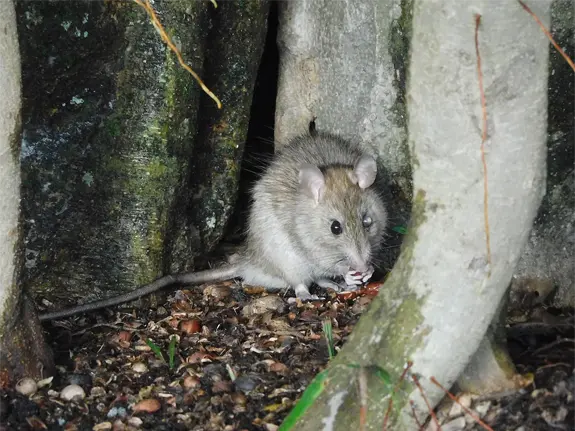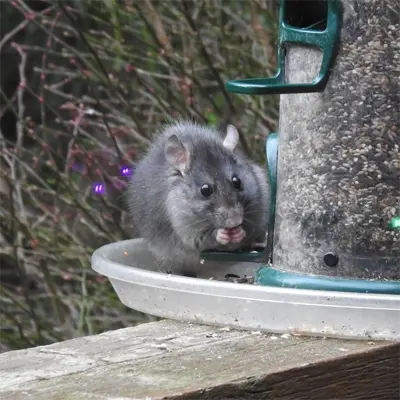Black Rats in Central Florida
The black rat (Rattus rattus) is an agile, arboreal rodent that can become established in and around homes and buildings in central Florida’s urban areas. Also known as the roof rat, black rats are adept climbers that nest above ground in trees, palm fronds, and attics.
This guide covers black rat identification, biology, behavior, health risks, and prevention and control methods for central Florida.
Appearance and Identification
Black rats have slender, lightweight builds with these key juvenile and adult features
Black rats are lankier than Norway rats with larger ears and tail. They’re incredibly agile climbers but poorer burrowers than Norway rats.
Maturation Rate
Young black rats grow rapidly, reaching independence within 1 month after birth. They achieve reproductive maturity around 3-4 months old. Adult size is attained by 3 months of age.
Habits and Behavior
Black rats are nocturnal and most active at dawn and dusk. They prefer elevated habitats like trees, utility poles, and upper levels of buildings. Black rats are adept climbers and travel along overhead utility lines, pipes, cables, and ropes. Inside structures they inhabit attics and walls, moving across ceilings and upper edges.
Outdoors black rats nest in palm fronds, dense ivy, and trees. They can access buildings through the tiniest openings with their nimble climbing and gnawing abilities. Black rats tend to be solitary compared to Norway rats.
Reproduction and Lifespan
Females begin breeding as early as 2-3 months old and can produce up to 6 litters per year. Typical litter size is 6 to 8 young and the gestation period lasts 21-23 days. Average lifespan in the wild is about 1 year but females may reach 18 months. Their high reproductive capacity allows quick population recovery after control efforts.
Ideal Habitat and Range
Central Florida’s warm, humid climate enables black rats to breed continuously. Average temperatures range from the low 70s°F (22°C) in north Florida to the upper 70s°F (25°C) in the south. Summer highs reach the 90s°F (30s°C) and annual rainfall exceeds 50 inches (1270 mm).
Dense vegetation, farms, abundant fruit trees, and plentiful waste provide food and nesting sites. Black rats readily inhabit attics, palm fronds, and trees. Older buildings with openings allow easy entry. Given suitable food, water, harborage, and mild weather, black rat populations multiply rapidly in central Florida settings.
Diet and Feeding
Black rats are omnivores and eat a wide variety of foods. Their diet includes:
- Fruits – mangoes, oranges, berries, etc.
- Nuts, seeds, grains.
- Garden veggies – corn, peas, tomatoes.
- Snails, insects, eggs.
- Pet food.
- Meat scraps, fish.
- Dairy products like cheese.
Black rats require about 1 ounce of food and water daily. They don’t need to drink if eating moist foods. Black rats forage at night and travel over 150 feet (46 meters) from nests to find food.


Common Health Risks
Black rats can directly or indirectly transmit many diseases to humans:
- Leptospirosis – Spread through infected urine on surfaces. Causes fever, chills, vomiting.
- Salmonellosis – Spread by feces contamination. Diarrhea, fever, abdominal cramps.
- Rat bite fever – Transmitted by infected rat saliva from bites. Muscle pain, vomiting, headache, fever.
- Hantavirus – Spread by deer mice but black rats may carry. Often fatal lung infection.
- Plague – Caused by Yersinia pestis bacteria and spread by infected rat fleas. Requires prompt treatment.
- Rickettsial diseases like typhus – Spread by infected rat fleas.
Black rats also trigger allergic reactions and asthma from the debris, urine, and allergens they spread in infested areas. Timely control is vital to avoid health issues.
Preventing Florida Black Rat Infestation
Effective prevention involves sealing all indoor and outdoor entry points. Use steel wool, copper mesh, cement, or metal plates to exclude rats from openings along foundations, vents, pipes, doors, windows, and other areas.
Trim back vegetation touching buildings. Manage food waste and pet food properly. Traps and rodenticides can remove existing rat populations when necessary.

Population Control Methods
If exclusion alone is insufficient to prevent Florida water rat damage, lethal control using traps or rodenticides may be considered. Traps such as snap traps, cage traps, or body-grip traps can humanely capture rats for relocation or euthanasia. Glue boards are another trapping option.
Poison baits are also effective but must be used cautiously around waterways. Zinc phosphide baits are commonly used though anticoagulant baits are safer for wildlife. Control is most effective when animals are active in spring through fall – winter trapping is less productive.
Always follow label directions carefully when utilizing any rodenticides.
Black Rats in Central Florida – Conclusion
Black rats pose risks through structural infestations, gnawing damage, and disease transmission in central Florida. But following integrated pest management principles of inspection, exclusion, sanitation, and population control can prevent infestations.
Signs like rub marks, droppings, noises, and gnawing indicate black rats may be present. Professional rat control services are recommended if an infestation is found to eliminate rats and prevent re-infestation.
With preventive measures and removal when needed, black rats can be kept out of central Florida homes and buildings.







